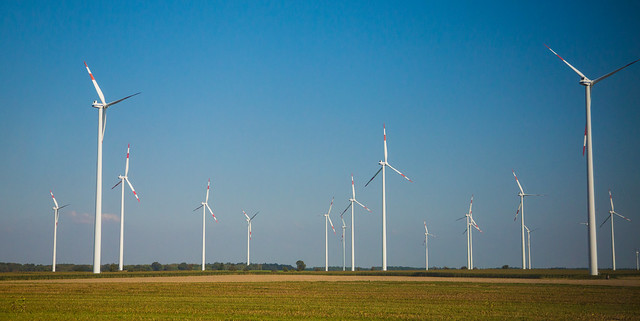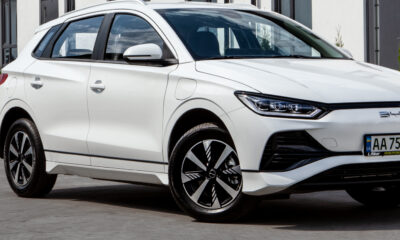Human Interest
Electric vehicles – how efficient?
Electric vehicles are only as efficient as the electricity to charge them. To get that juice from renewables alone would take 3.7% of American land.

Earlier, CNAV treated the environmental soundness of electric vehicles. A German study released this week showed battery-powered electric vehicles are not nearly as environmentally sound as people imagine. In fact the study authors assert that even a Diesel vehicle does the environment less harm than an electric vehicle. That sounds totally counterintuitive, but has sound science behind it. The best way to see why electric vehicles will not save the planet—yet–is to understand their worst failing. That failing is efficiency, from the first fuel source to the wheels that give a vehicle its name.
How to measure efficiency
Energy efficiency, according to this article in Wikipedia, is the ratio of work done to energy put in. Energy, from the Greek en- within and ergon a work, is the ability to do work. In this case, moving a vehicle down a road takes work.
The Otto engine, that most conventional vehicles use, is least efficient at about 35 percent, best-case. Diesel engines fare better, at about 45 percent.
The steam turbine that runs your local power plant is slightly less efficient than a Diesel engine. It scores about 42 percent, give or take one. On this figure depends every calculation about the efficiency of a power plant that burns its fuel. With one exception: natural gas power plants, using a combined steam and gas turbine cycle, can score 60 percent efficient.
Bright Hub Engineering rates the efficiency of different electric power plants. They also score natural gas at 60 percent efficient. Coal-fired plants score 48 percent, best-case.
A word about nuclear power
Nuclear power plants are the least efficient of all. Their thermal efficiency is 38 percent, but their overall efficiency is lower still, at 0.27 percent. But the tremendous amount of energy from nuclear fission makes them viable, and their power cheap. That very low efficiency figure suggests much room for improvement. That improvement would lie in capturing more energy from fission to put into the steam turbine.
Two different kinds of solar plants
One can capture energy from the sun (on the ground) in one of two ways. Simply boiling water for a steam turbine yields an efficiency of 20 percent, even in summer. Photovoltaic cells do almost twice as well. Wikipedia cites efficiencies from a low of about 33 percent up to 46 percent for the best modern designs.
This Earth receives an average daily dose of the Sun’s rays amounting to about 1000 watts per square meter. A solar boiler could achieve 200 watts per square meter of the mirrors required. Photovoltaic cells might generate as many as 300 watts per square meter, or more. Bear this in mind when trying to replace non-renewables by renewables—completely.
Other renewable sources
A hydroelectric dam can boast 80 or 90 percent efficiency, if one has a nearby river. One must also remember that one can put only so many dams in a river. Put in one too many, and the river slows to a trickle and helps no one.
A wind turbine scores at 30 to 45 percent. That depends on how strongly the wind blows and how quickly it can turn to face a gust. Gusts never blow in the prevailing direction.
Solar and wind energy are intermittent. To solve that problem, one must use a battery, either at the power plant or anywhere else in the grid. This article describes techniques for “grid energy storage” in use or development.
Efficiency of electric vehicles
Too many policymakers have decided to measure efficiency of electric vehicles in the vehicle itself. Electric vehicles, according to this report, can score 73 percent efficient using battery power. (Fuel-cell vehicles score surprisingly low, at 22 percent.) But this report measures the efficiency of the power from grid to wheels.
Almost ten years ago (in fact, two days before the Climategate story broke), Tom and Cathy Saxton scored electric vehicles at 80 percent efficient. Again, they measured efficiency in the vehicle, not for making the energy to put in.
The Saxtons also cited references that are no longer available. Happily, the Wayback Machine can bring them both back. Why the sources took those down, one can only speculate.
Can the grid stand the strain?
First is the “Wellinghoff Report” on whether enough electric power existed to run millions more electric vehicles. This report looked at plug-in hybrids, not the all-electric vehicles of today. The Report calculated that the grid could support a 73 percent replacement of “light duty vehicles” by plug-in hybrids. Light duty here means “cars, pickup trucks, SUVs and vans.” Those figures hold for plug-in hybrids. All-electric vehicles need much more power, because they use no other fuel.
So even nine and a half years ago, the government never thought the grid could support replacing every car, etc. even with a plug-in hybrid. It could support an even lower replacement by battery-powered electric vehicles. That assumes no one builds any more power plants, nor shuts any existing plants down. But the Green New Deal calls for replacing coal, natural gas, oil, and nuclear energy with renewables only.
Tesla’s calculations of “well-to-wheels” efficiency for electric vehicles
Second is the efficiency calculations page Tesla maintained at the time. Tellingly, Tesla does not maintain this page anymore. The direct link redirects to a page advertising Tesla’s charging options for the electric vehicles it makes. But the Wayback Machine shows us what Tesla was saying nine and a half years ago.
For electric vehicles, Tesla went to the “well” of natural gas. Natural gas carries most of the “peak load” for electricity; coal carries the rest. (Nuclear power carries the base load.) Tesla quoted 52.5 percent “well-to-station” efficiency, which agrees with 60 percent efficiency of natural gas power plants. Then they failed to “show their work” for calculating “vehicle mileage” and “vehicle efficiency.” So for what it’s worth, they boasted that their electric vehicles were twice as efficient as the best hybrids, three times as efficient as a hydrogen fuel cell vehicle, and seven times as efficient as a “muscle car” (like the Chevrolet Corvette®).
Conclusion: we don’t know
Even when Tesla kept up a calculations page, they didn’t “show their work.” So we cannot know how efficient electric vehicles truly are. Recall that German study showing that electric vehicles cause more “emissions” than they spare. Their manufacture causes the greatest amount of emissions. Driving them provokes more, in a country that gets its energy from coal.
More to the point: electric vehicles are the means for using “renewables” to power transportation. That applies to ground transportation only. (Recall also that the GND proposes totally obviating air transport, with no distinction between overland and overseas flights!)
Complete renewable replacement
The site Statista.com shows the total energy budget of American civilization, by source. If electric vehicles score 73 percent efficient after charging, then perhaps one-half of the total energy contribution from crude oil would suffice. That comes to 18 quadrillion BTU, or 18 quintillion Joules, per year. (1 BTU comes to a thousand Joules, in reasonably round figures.) This takes into account the use of petroleum in industry and aviation. Electric motors can replace piston engines but not jet engines. Forget trying to do without air travel. Instead, someone will need to develop a jet engine that uses hydrogen instead of kerosene.
That still leaves natural gas and coal to replace totally. Total budget: 41 quadrillion BTU, or 41 quintillion Joules. Add nuclear power, because the Triumfeminae1 of the House want to replace that too. That’s another 8.5 quintillion Joules.
And the numbers come to…
So the replacement cost comes to 68 quintillion Joules per year. That’s one year, of 365.24 days, each having 24 hours of 3600 seconds each, or roughly 31.6 million seconds. Dividing 68 quintillion by 31.6 million, we arrive at 2.2 terawatts.
Strata.org studied the land footprints of various ways of making electric power. As one might expect, coal, natural gas, and nuclear power need 12 acres—0.049 square kilometer—per megawatt. Solar needs 0.20 square kilometer, wind 0.29, and hydro 1.27. The figure for the solar plant footprint assumes re-roofing single-family homes, office buildings, stores, factory hangars, and the like with new solar “shingles” or strap-on panels. Otherwise the required initial footprint would be nearly twice as broad.
The land footprint
So to make up 2.2 terawatts requires 440,000 square kilometers, or 440 billion square meters. To be fair, subtract the existing coal, natural gas, and nuclear footprints: 108,000 square kilometers. That leaves 332,000 square kilometers extra to get it done. (And if you add more wind or hydro into the mix, the footprint gets larger.)
The total land area of the USA is about 9.1 million square kilometers, or 9.1 trillion square meters. But that includes settled land, Native American reservations, rivers, and lakes. And in what remains, someone must find land equal to 3.7 percent of all the land in the United States.
Where are you going to find the land?
OK, ye Triumfeminae of the House! Where are you going to find all that land? Talk fast! You gave yourselves and the country ten years!
Or did you in fact plan to confiscate all “light-duty vehicles” except for police and military vehicles and official limousines? And maybe jam everyone into some of Paolo Soleri’s Arcologies and get the extra land that way? To paraphrase a popular scandal rag, inquiring minds want to know. Inquiring minds also want to know why civilization should stagnate, as it must under this regime.
One final word: the accident hazard
Remember, too, one last hazard of electric vehicles. “One false move, and ZAP!” So said an automobile mechanic working on plug-in hybrid models. The batteries in all-electric vehicles are even more dangerous, not only to mechanics but also to emergency first responders.
About the image
These wind turbines stand somewhere along the road from Hamburg to Berlin, in Germany. Wind power has an even larger footprint-per-unit-power than does ground-based solar power.
“Wind Turbines” by Tony Webster is licensed under CC BY 2.0. To view a copy of this license, visit: https://creativecommons.org/licenses/by/2.0.
1 A triumfemina or triumfem is the female counterpart to a triumvir. The Triumfeminate of the House includes Reps. Alexandria Ocasio-Cortez (D-N.Y.), Rashida Tlaib (D-Mich.), and Ilhan Omar (D-Minn). They back each other up in everything each of them says or drops into the hopper. Caesar, Pompey, and Crassus did one another such favors in ancient Rome. And through sheer intimidation and virtue-signal desire, these three women, and not Rep. Nancy Pelosi (D-Calif.), Speaker of the House, lead the House.
Terry A. Hurlbut has been a student of politics, philosophy, and science for more than 35 years. He is a graduate of Yale College and has served as a physician-level laboratory administrator in a 250-bed community hospital. He also is a serious student of the Bible, is conversant in its two primary original languages, and has followed the creation-science movement closely since 1993.
-

 Executive2 days ago
Executive2 days agoJanuary 6 case comes down to selective prosecution
-

 Executive1 day ago
Executive1 day agoBiden ballot woes continue
-

 News2 days ago
News2 days agoRolling the Dice on Republicans: Has the Right Become Delusional?
-

 Civilization1 day ago
Civilization1 day agoPresident Biden Must Not Encourage Illegal Mass Migration From Haiti
-

 Executive2 days ago
Executive2 days agoWhy Fatal Police Shootings Aren’t Declining: Some Uncomfortable Facts
-

 Guest Columns1 day ago
Guest Columns1 day agoWhat Was Won in No Labels’ Crusade
-

 Civilization2 days ago
Civilization2 days agoBiology, the Supreme Court, and truth
-

 Entertainment Today2 days ago
Entertainment Today2 days agoWaste of the Day: Throwback Thursday: Millions Went To Video Game ‘Research’















[…] Electric vehicles – how efficient? […]